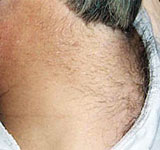Hello,
I had a transplant of over 3,000 follicles about 9 months ago. I have seen growth but it is still thin and not what I have expected. I have noticed major shedding about 7 months in with the hairs having white bulbs attached to the end. I am concerned that some may be transplanted hairs. What could be the cause of this? Should I be worried?

I do not know what is going on in your case, so I could just guess. Maybe you have increasing native (non-transplanted) hair loss. Maybe you have other medical problems. Maybe your hair transplant was not a success. Maybe you have diffuse unpatterned alopecia (DUPA), which would produce failures to hair transplant surgery. Maybe you are not on Propecia. Maybe you stopped Propecia. ANYTHING is possible. And I would be worried too.
You should be asking your surgeon about the problem and he should be really worried for you. Please, contact your surgeon and discuss these issues with him!

 Neck hair is not considered “permanent” like the hair on the back of your scalp. There is a chance that as you get older your neck hair will fall out, so if neck hairs were used for a hair transplant it would also fall out. This is what makes neck hair not ideal for transplantation.
Neck hair is not considered “permanent” like the hair on the back of your scalp. There is a chance that as you get older your neck hair will fall out, so if neck hairs were used for a hair transplant it would also fall out. This is what makes neck hair not ideal for transplantation. Any stress could potentially cause hair loss (called
Any stress could potentially cause hair loss (called  So you took Propecia for years (including follow-up visits and prescription renewals) and somehow were never informed of any side effect potential, nor did you even read the insert that comes with the medication? If you have not had any side effects after 4 years, it would be unlikely that you will experience them now or at any time. I believe erectile dysfunction risks are about 1%, libido decrease 1%, breast enlargement much less than 1%. You should be in discussion with your prescribing doctor, not me over the internet.
So you took Propecia for years (including follow-up visits and prescription renewals) and somehow were never informed of any side effect potential, nor did you even read the insert that comes with the medication? If you have not had any side effects after 4 years, it would be unlikely that you will experience them now or at any time. I believe erectile dysfunction risks are about 1%, libido decrease 1%, breast enlargement much less than 1%. You should be in discussion with your prescribing doctor, not me over the internet. Read the full text —
Read the full text —